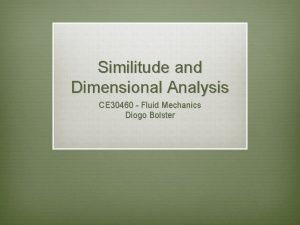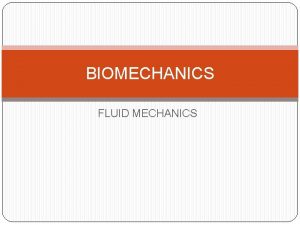Dimensional Analysis In the application of fluid mechanics












- Slides: 12

Dimensional Analysis

�In the application of fluid mechanics in designs make much of the use of empirical results from a lot of experiments. This data is often difficult to present in a readable form. Dimensional analysis provides a strategy for choosing relevant data and how it should be presented. �This is a useful technique in all experimentally based areas of study. If it is possible to identify the factors involved in a physical situation, dimensional analysis can form a relationship between them.

�Dimensions and units Dimensions are properties which can be measured. Units are the standard elements we use to quantify these dimensions. �In dimensional analysis we are concerned with the nature of the dimension i. e. its quality not its quantity. The following common abbreviation are used: �length = L �mass = M �time = T �force = F

SI & English Units Quantity SI English Dimension Length Meter, m Foot, ft L Mass Kilogram, kg Bound, lb M Time Second, s T Velocity m/s ft/s L/T Acceleration m/s 2 Ft/s 2 L/T 2 Force Kg m/s 2 = N Pressure N/m 2 = Pascal Poundal/m 2 M/LT 2 Density Kg/m 3 lb/ft 3 M/L 3 Specific Weight N/m 3 Poundal/ft 3 M/L 2 T 2 Viscosity N s/m 2 Poundal s/ft 2 M/LT Surface Tension N/m Poundal/ft M/T 2 lb ft/s 2 = poundal M L /T 2

�Dimensional Homogeneity Any equation describing a physical situation will only be true if both sides have the same dimensions. That is it must be dimensionally homogenous. Example The equation which gives flow over a rectangular weir

�The left right hand side has dimensions: = L (L T-2)0. 5 L 1. 5 = L 3 T-1 �The left hand side = L 3 T-1 Which is equal to the dimension of the right hand side. i. e. the equation is dimensionally homogenous.

�Results of dimensional analysis The result of performing dimensional analysis on a physical problem is a single equation. This equation relates all of the physical factors involved to one another. This is probably best seen in an example. �If we want to find the force on a propeller blade we must first decide what might influence this force. It would be reasonable to assume that the force, F, depends on the following physical properties: �diameter, d �forward velocity of the propeller (velocity of the plane), u �fluid density, ρ �revolutions per second, N �fluid viscosity, μ

�Before we do any analysis we can write this equation: F = φ (d, u, ρ, N, μ) Which can be also written as F = K d a u b ρc N e μj Or 0 = φ1 (F, K, d, u, ρ, N, μ) Where K is constant and a, b, c, e and j are unknown constant exponent. From dimensional analysis we can obtain these exponents and from experiments we can determine K.

�Buckingham’s π theorems Although there are other methods of performing dimensional analysis, the method based on the Buckingham π theorems gives a good generalized strategy for obtaining a solution. There are two theorems accredited to Buckingham, and know as his π theorems.

� 1 st π theorem: A relationship between m variables (physical properties such as velocity, density etc. ) can be expressed as a relationship between m-n nondimensional groups of variables (called π groups), where n is the number of fundamental dimensions (such as mass, length and time) required to express the variables. � 2 nd π theorem Each π group is a function of n governing or repeating variables plus one of the remaining variables.

�Choice of repeating variables Repeating variables are those which we think will appear in all or most of the π groups. Before commencing analysis of a problem one must choose the repeating variables. Some rules which should be followed are i. From the 2 nd theorem there can be n ( = 3) repeating variables. ii. When combined, these repeating variables variable must contain all of dimensions (M, L, T) iii. A combination of the repeating variables must not form a dimensionless group. The repeating variables do not have to appear in all π groups.

v. The repeating variables should be chosen to be measurable in an experimental investigation. They should be of major interest to the designer. For example, pipe diameter (dimension L) is more useful and measurable than roughness height (also dimension L). �In fluids it is usually possible to take ρ, u and d as the three repeating variables. �This freedom of choice results in there being many different π groups which can be formed - and all are valid. There is not really a wrong choice.
 Dimensionless groups in fluid mechanics
Dimensionless groups in fluid mechanics Dimensional analysis fluid mechanics
Dimensional analysis fluid mechanics Fluid kinematics
Fluid kinematics Circular motion is one dimensional or two dimensional
Circular motion is one dimensional or two dimensional Fluid sf
Fluid sf P1-p2
P1-p2 Fluid statics deals with
Fluid statics deals with Intracellular fluid and extracellular fluid examples
Intracellular fluid and extracellular fluid examples How does water go through your body
How does water go through your body Hypoosmotic
Hypoosmotic Extracellular fluid and interstitial fluid
Extracellular fluid and interstitial fluid Fluid thrill amount
Fluid thrill amount Equazione di navier stokes
Equazione di navier stokes























